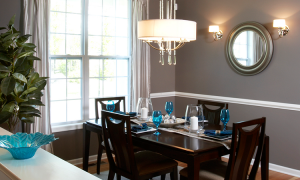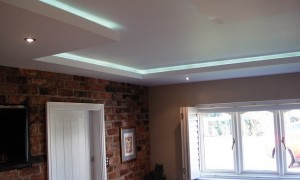Lighten Up: The Ultimate Guide to Illuminating the Modern Home
From The Home Depot and Coldwell Banker

Photo Courtesy of Kerrie Kelly Design Lab
Your house may have fabulous furnishings and impeccable decor, but there’s one little element that could throw your entire look out of alignment: the lighting. It’s a seemingly small detail, but lighting can make or break a home’s overall design.
Good lighting is essential to building a home that feels comfortable, cohesive and complete. From technical details like sizing and wattage to more stylistic concerns and smart lighting solutions, this guide will help you create a lighting plan that will transform the feel of your home.
I. Illumination 101
How much do you really know about lighting? Between assessing lumens and choosing from among thousands of fixtures, the subject can quickly get murky. The good news is, you can break down all of the types of lighting available into three basic categories: ambient, task and accent lighting.
Interior designer Kerrie Kelly lays it out for us:
The ideal lighting scheme is natural light supplemented with ambient, task and accent lighting. The combination of lighting and sunlight can completely change the feeling of a home. A balanced mix sustains the warmth of a room while allowing homeowners to create different moods.
Ambient sets the room’s mood. The even glow fills the space and makes it more inviting by eliminating harsh shadows. It is usually provided by indirect fixtures such as shaded lamps, overhead lighting and chandeliers, though it can also be achieved with directional fixtures aimed at a wall, or built-in lighting in a cove or cornice.
Forest Ave SE Mercer Island, WA
Task lighting is the bright light that illuminates a particular area where an activity takes place, such as reading, playing games or preparing food. The pattern of light is focused tightly onto a specific space, and its sharper pool of light often contrasts pleasantly with overall ambient light. Task lighting must be adjustable and able to be shielded. It’s best to aim task lighting at an angle to avoid hot spots or shadows.
N Mockingbird Lane Paradise Valley, AZ
Accent lighting includes the most romantic light, which comes from the flicker of candles. It’s also used to highlight features, such as artwork or architectural elements, or to provide a sense of drama. The beam spread, intensity and color are important considerations when choosing accent lighting.
208 Hawthorne Hollow Road Madisonville, Louisiana
“The best lighting schemes combine these three different types of lighting without overusing any of them,” Kelly says. “Using too many lights or high-wattage bulbs can wash out a room’s beauty, while insufficient lighting can create a room that is cold and uninviting. Finding the right mix can be tricky, but it is worth the time and effort.”

Good lighting is extremely important, and it’s one of the most overlooked considerations when designing a home. Lighting can determine the mood of a room. Swap out on/off light switches for dimmers, especially in the dining and living rooms. When you need bright light to clean, it’s there, or you can turn the lights down a bit when entertaining for a cozy feel. —Sarah Fishburne, Director of Trend and Design at The Home Depot

Photo Courtesy of Kerrie Kelly Design Lab
Creating a Lighting Scheme
Once you’ve gotten an understanding of what different types of lighting achieve in your home, you can assess your home’s needs and start to create a lighting scheme.
“People look for homes with good light,” says Coldwell Banker’s Cara Ameer. “Even if the home tends to look darker due to its lot and geographic location, good lighting can help offset some of the areas of the home that may translate as darker spaces.” In other words, a thoughtfully created lighting scheme can make all the difference in the world.
Layering is the key to creating a balanced lighting scheme, according to Kelly. Here’s how to get started:
- Identify the main activity areas or the room’s focal points and put the brightest layer of light there.
- Create a middle layer to highlight interest in specific areas, without detracting from the focal points.
- Use the third layer to fill in the background with ambient light.
II. Room-by-Room Lighting Guide
Creating a successful lighting scheme is a big-picture task, but that doesn’t mean you shouldn’t take a closer look at each room in your house. In fact, you’ll need to assess each space individually in order to create a plan that flows beautifully and effortlessly, filling your home with light.

The fixtures should be proportionate to the space. A larger space with higher ceilings can support a more significant fixture. A smaller space may need something more understated that will complement but not overwhelm. —Cara Ameer, Coldwell Banker

Photo Courtesy of Kerrie Kelly Design Lab
Living Room — Living rooms tend to vary widely in terms of size, location and use, so assess your unique situation and plan from there. A smaller space may simply require a few strategically placed lamps, while a larger room may require a flush light fixture.
- In warmer climates, consider fan/light fixture combination to help maintain a more comfortable temperature and healthy air flow.
- Use task lighting to highlight spaces where you’re most likely to read or do any other activities that require a bit of extra light.

Photo Courtesy of Kerrie Kelly Design Lab
Kitchen — If you’re like most people, you think of your kitchen as the heart of your home—a multiuse space where you work and socialize. Because you and your family spend so much time in the kitchen, look for fixtures that are warm and inviting yet still hard-working. “You want something that is casual but elegant, and also something that is timeless and not too trendy,” Ameer says. “You will want it to be flexible and adaptable to a variety of furniture styles. Think transitional.”
Try these ideas for lighting up your kitchen:
If you have high ceilings, pendant lights can highlight a bar area or island.
- Use under-cabinet lighting to brighten up the kitchen in a subtle way without having to see light fixtures.
- For an eat-in kitchen, take into account the size and shape of your kitchen table before choosing a fixture. Ideally, you’ll want something in a similar style and appropriate size.
- Try adding several low-voltage halogen fixtures with a narrow flood beam distribution and focusing them on specific task areas.

Photo Courtesy of Kerrie Kelly Design Lab
Dining Room — This is one room where it’s always safe to make a statement. “Choose a fixture that gets noticed in an attractive way and creates interest in the space,” Ameer says. “The fixture should help create ambience for the room, as this is a space that is used for entertaining and gatherings. Make sure it is transitional and coordinates well with your dining room furniture.”
- Chandeliers with lampshades, stately candelabras and fixtures with strategically placed crystal or glass pendants can help to create a more dramatic look.
- Avoid fixtures that are overly bright or brassy.
- Consider your dining room ceiling height along with the size and shape of your table.

The proper height to hang a light depends on the height of the ceiling and your family. In general, it should be about 84” to 96” from the floor, but always make sure it clears the tallest person in the family by at least 12”. —Sarah Fishburne, The Home Depot

Photo Courtesy of Kerrie Kelly Design Lab
Bathroom — As the place where most people get ready in the morning, your bathroom should be a top priority room for lighting design. An ill-placed fixture or bulb could be the difference between you starting your day with confidence or feeling self-conscious. Fixtures should be situated at a certain angle so as to shine light on the face in the most natural way.
- Avoid using downlights over the vanity without adding lights on the side. Standing directly under a downlight creates exaggerated and unflattering shadows.
- Use multiple sources of light—warm light is more flattering, but cool light is better for close-up grooming tasks.
- Use lighting to highlight accessories in your bathroom.
- If your ceiling height allows, try adding a small chandelier over your master bathtub to bring a bit of elegance to your space.

Avoid Broadway lighting over bathroom mirrors—they’re best left on Broadway. Think of new ways to incorporate lighting into your bathroom with a variety of new styles in vanity wall mounted fixtures. — Kerrie Kelly, Design Lab

Photo Courtesy of Kerrie Kelly Design Lab
Bedrooms — Lighting can bring a lot of personality to a bedroom. “The bedroom is a space in which lighting can add both fun and function,” Kelly says. “If you have bedside tables, consider adding oversized lamps to create a luxe feel or smaller table lamps to dressers or desks for a functional fix.”
- Using multiple light sources adds warmth and dimension to the room, which can help a bedroom feel more relaxing.
- Consider the size of the bedrooms along with ceiling heights. For standard bedroom size ceilings (8-10 ft.), a smaller overhead light fixture should be appropriate paired with lamps on a nightstand or two.
- For a larger bedroom like a master suite, try bringing in a smaller chandelier to add a touch of opulence.
- A ceiling fan with a light fixture can make sleeping more comfortable in warmer climates.

Lamps are a great way to create height within a room. Vary heights of table and floor lamps to help add interest to a space. —Sarah Fishburne, The Home Depot

Photo Courtesy of Kerrie Kelly Design Lab
Outdoor — As the first thing people see when they pull up to your home, outdoor lighting is hugely important. “Landscape lighting makes a huge statement in a yard,” Fishburne says. “Use spotlights to highlight your home’s architectural or landscape details, or use pathway lights to illuminate the way at night.”
Upgrade your lighting by replacing the builder-grade exterior light package with something more modern.
- Add motion-activated lights to ensure your outdoor space is as safe as possible.
- “The biggest trend that we’re celebrating for the outdoors is stringed lighting and hurricane lamps. Multicolor strung lighting can create a festive feel for special events or can be hung year-round if yellow or white.” —Kerrie Kelly
- A hanging pendant light may provide a nice finishing touch in a tall covered entry, while a smaller pendant or flush light fixture can finish the look of a small space.

Updated fixtures that reflect current and on trend finishes and styles can easily help transform indoor and outdoor spaces. They are like the ‘jewelry’ of the house. Change the jewelry to change the look of the outfit. —Cara Ameer, Coldwell Banker
III. Lighting Technology and Trends
See more of this beautiful Aspen, CO currently listed with Coldwell Banker Mason Morse Real Estate
There’s more than one way to take an intelligent approach to lighting your home. The ever-growing range of smart lighting options on the market today makes it easier than ever to bring your lighting into the modern age. A segment of home automation, smart lighting can be controlled wirelessly from both inside and outside the home, via an Internet connection and an app on a mobile device or computer. Benefits range from security and safety to convenience and even cost and energy savings.
Greg Rhoades, Director of Marketing for Leviton Security & Automation, explains that smart lighting allows homeowners to illuminate their property based on their specific habits and activities. “When heading to bed, turn off all lights with one button or automatically at a certain time each night,” he says. “Press another button to dim certain lights for a party and turn off lights in areas where you don’t want people mingling.”
There are many variations of smart lighting. You can have your lighting turn blue if it’s raining outside, flash when you get an important email, or simulate the dawn light when it’s time to get up. You can also set it to turn on and off randomly as a security feature when you’re away from home.

Automated lighting systems are not expensive to implement today. In fact, retrofits are incredibly popular thanks to technologies that communicate over a power line, or more commonly, wirelessly. Additionally, plug-in modules are the easiest devices to implement as they don’t require a technical installation by an electrician. —Greg Rhoades, Leviton Security & Home Automation
Three Smart Lighting Solutions
Plug-In Modules and Smart Bulbs — These are currently the easiest options on the market. Simply screw in your light bulb or plug your lamp into a plug-in module, download an app and connect over Wi-Fi to the “hub” that came with the system. Smart plugs cost about $50 each, while smart bulbs range from $25 to $120 for a starter kit of two bulbs and a hub. Then you can expand your system from there for between $15 and $60 per bulb.
Smart Switches — If you want to implement a fully connected home, smart switches are the best choice. Combined with plug-in modules for standalone lights, this is the easiest way to create a full system. Smart switches simply replace your existing switch and provide instant smarts to your lighting. They start at around $50 and go up as you add features such as dimming and motion sensing, and you will need a compatible smart home hub to power them—these range in prices from $50 to $200.
Occupancy Sensing —With built-in sensors or connected sensors, lighting knows when you enter a room and/or if there is anyone in the room, allowing it to turn itself on and off accordingly. Commonly seen in offices, occupancy sensing lighting can also work well in a home. It can be done via wall-mounted devices or light switches that communicate either via wires or wirelessly to your light bulbs. The sensors cost between $50 and $90, and you may need more than one per room. Occupancy sensing light bulbs are not yet available to consumers, although a company called Stack has a model due for release this year. A starter pack with two bulbs and a hub is $150, additional bulbs are $60.
Know Your Bulbs
All smart bulbs are LEDs, which is good news for the environment—the Environmental Protection Agency has estimated that if every household replaced just one incandescent bulb with an Energy Star rated LED bulb, Americans would save $700 million per year in energy costs. Imagine what switching out your whole house could do for your energy savings!
With the end of incandescent light bulb manufacturing in the U.S. last year, standard LED bulbs and CFLs (compact fluorescent) are now the only choice for American consumers. Let’s break down a few of their key differences.
- CFLs are more energy efficient than incandescents and provide almost identical light. So if you are very attached to the warm glow of incandescents, CFLS are a good alternative (although the quality of light LEDs produce has improved dramatically in recent years, making it easier to replace like for like).
- CFLs are less expensive than LEDS, but they don’t last as long and they contain mercury, making them a less eco-friendly option. However, for rooms that see little use, such as a garden shed or attic, CFLs are a good option over incandescents if you are looking to save money and energy.

The wattage and hue of the light bulbs used can absolutely change the look of a space. Brighter lights make spaces stand out and help create the perception of a larger space, even if it is not. —Cara Ameer, Coldwell Banker
A final option for energy efficient lighting is solar-powered lighting. Solar power uses no electricity, making it far and away the most efficient choice. However, current solar power hasn’t been successfully and inexpensively adapted for indoor use. While this will change as technology advances, for now, solar is an excellent option for outdoor lighting. Its big advantage—that it doesn’t require wiring or use any electricity—makes it perfect for the garden or yard.

Using smart programming with a lighting control system can save money. For instance, it is estimated that a single LED bulb burning at eight hours per day will cost $26.40 over five years. However, automatically dimming that light to just 85 percent will save 20 percent in electricity usage. —Greg Rhoades, Leviton Security & Home Automation
Conclusion—Flipping the Switch
Lighting up your home may not be as simple as it once was—but that’s a good thing. By thoughtfully assessing your space, weighing the pros and cons of different fixtures, and exploring the exciting world of smart lighting, you can create a fully customized lighting plan that will benefit your life every single day.
Start by accessing your needs in each room, thinking from the perspective of ambient, task and accent lighting. Then, consider the specific types of fixtures that will work best for your unique situation in each room. Finally, get smart about choosing bulbs that will last for years, providing the illumination—and the automated functionality—that will improve your family’s life at home.










2 Comments
Sabrina Seabrooks
September 13, 2015This was the best article ever. Thank you!Thank you!! Thank you! !!!!
Lindsay Listanski
September 24, 2015We are so pleased you liked it Sabrina! Appreciate you stopping by!